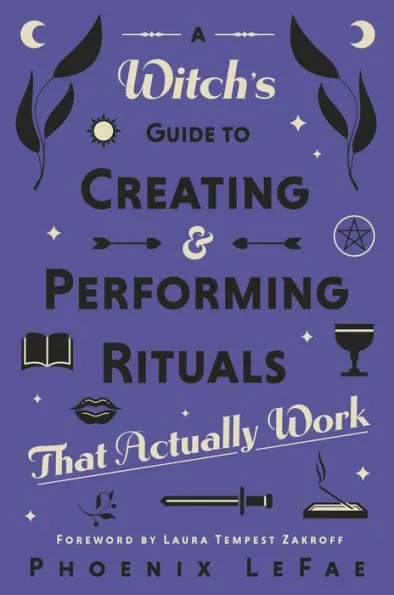This is a practical, accessible, and information-packed book, excellent for both beginning and experienced ritualists.
Phoenix LeFae is a well-known author and shop owner in the witchcraft community. Last year, we reviewed her most recent book, Witches, Heretics and Warrior Women. With her new book, she raises a tricky proposition: a ritual that will “actually work.” How is one to know? LeFae points a reader to carefully consider what is most likely to work, as opposed to just going through the motions.
Early on, LeFae notes the confusion with the words ritual, spell, and meditation because they are similar and are used interchangeably. A ritual can be a daily action like taking vitamins, or something done “with reverence or specific directed energy.” A spell is a type of ritual. It might involve a set up and closing, chants or spoken words. A meditation may resemble a ritual, either as a daily practice or in a group with a guided meditation. Le Fae’s point is just that with rituals, both solitary or in groups, no one size fits all, and to not fret over terminology.
The book is organized along three dimensions: breath, bone, and blood. The breath of ritual is the inspiration and intention for planning it. The bones are the format and instructions. The blood is the drama and energy, what makes a ritual process flow, including things that may even go unnoticed by participants.
For starters, LeFae asks: where does ritual even come from? It comes from the same place that art comes from, she writes. “Ritual is a product of desire.” This line became my major take-away from this book. A ritual may come from a desire to worship, a desire to celebrate a seasonal shift, a desire to shift consciousness or the flow of events. Whereas some non-pagan spiritual traditions seek to ignore or suppress desire, witchcraft welcomes desire as wholesome and necessary. Desire animates ritual acts and speech.
“After the initial spark of desire,” Le Fae proceeds, “the next step is to determine the why of the situation.” A ritual intention is a sentence or two on why you’re doing what you’re doing. Writing it down will bring clarity to the work.
Once one is clear in intention, then, the sky’s the limit as to a ritual’s participants, supplies, correspondences, time and place. LeFae covers working with Moon phases, a little bit of zodiacal astrology, colors, stones, plants, oils, and such. For the bones of a ritual, she’s got material on altars, ritual tools and how to clean and use them. She’s got brief discussions of how to draw different types of invoking and ritual-ending pentacles. Things can be plain or elaborate. She’s got advice for how to handle groups large and small, in rental halls, outdoors and when visited by unexpected wildlife, with snafus like flaming cauldrons or someone’s hair set on fire, all in a spirit of improvisation and humor.
In her chapter on “Creating Your Own Rituals,” LeFae reminds readers that while modern witches and pagans may believe that their rites “were practiced by pre-Christian peoples,” that’s really not the case. There has been a lot of influence from occult writings of the 1500s through the 1800s. But “for the most part,” she writes, “our modern Witchcraft rituals are just that: modern.” She brings this up, she says, “because of the homogenization and whitewashing of these celebrations and rituals. These rituals work… but they might not be as effective or impactful for you as an individual with your own practice.” She is less interested in a ritual’s historical pedigree than in getting readers to make their own rituals. These are the ones that will “actually work.”
“The first step in creating a cycle of celebration for your own practice is to have a relationship with where you live. This requires you to pay attention to the shifts in weather, animal migrations, local celebrations, and subtle changes in your area.” If you live in California, for example, you might not be celebrating winter solstice in front of a roaring fire. You might, instead, be wearing shorts and a t-shirt and waiting for the daffodils and ornamental plum trees to bloom a few weeks later, in February.
What “works,” then, is what is local and pertinent, like a daily ritual of rising with a deep and intentional breath, saying something like “Today will be a glorious day. I am grateful for this day,” putting your feet on the floor and drinking a glass of water, then doing some meditation or breathwork, some movement or journaling--nothing fancy--then going about your day. What “works,” on a daily basis, may be just that simple.
~review by Sara R. Diamond
Author: Phoenix LeFae
Llewellyn Publications, 2023
247, pp., $19.99

